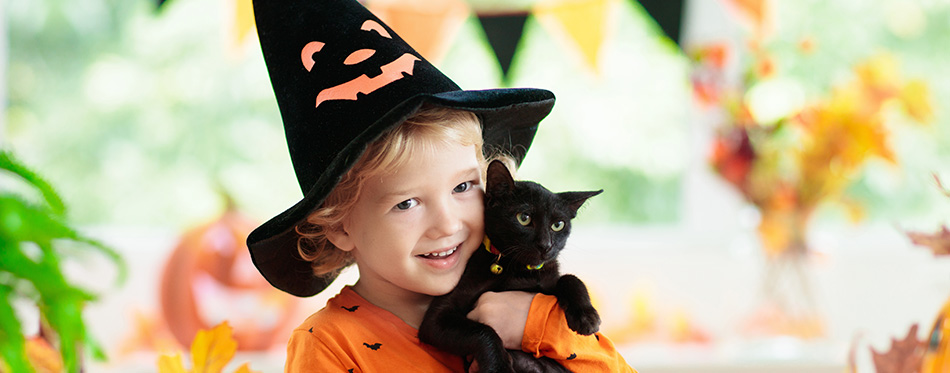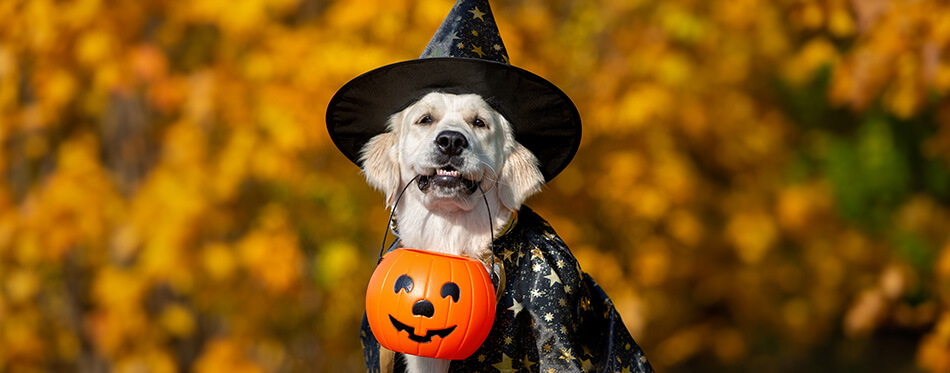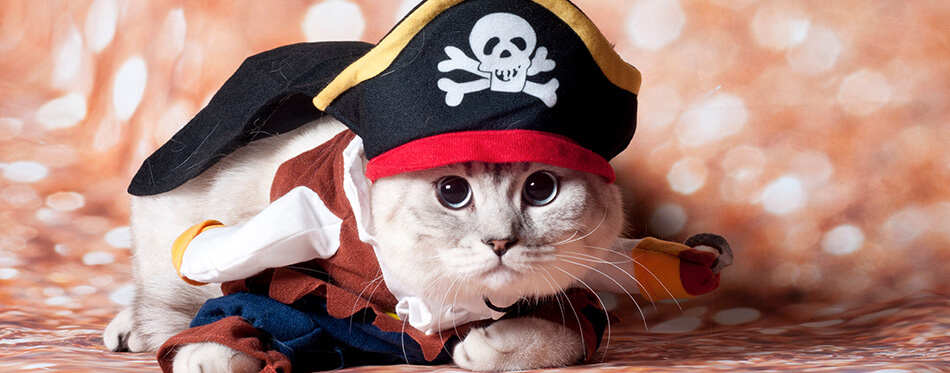If you’re anything like myself, you will be excitedly anticipating the arrival of Halloween and what duo costume you and your pet will be sporting this spooky season. Although, as exciting as Halloween may be, it does not come without its risks for pet owners. Even at the best of times, it can be difficult to keep an eye on our dogs, and Halloween is no exception. So here we have composed some important Halloween safety tips for pets, to ensure you and your pets can celebrate properly, without any worry.

Trick Vs Tempting Treats
October is a time to hand out and even indulge in a little Halloween candy. But don’t forget to keep these treats away from your pets. Candy, and even candy wrappers, can be hazardous to your furry friends for numerous reasons. Chief among them being that particular ingredients in candy can be toxic to your pets and that the wrappers themselves could be potential choking hazards.
Chocolate is likely to be one of the most common threats in households around Halloween – which is known to be toxic to dogs. So be sure to keep it well out of your dog’s reach. Even sugar-free candy can cause digestive distress due to a harmful ingredient known as ‘Xylitol’ which has been known to provoke seizures and cause intestinal blockage, liver failure, and drops in blood sugar.
Can Cats Eat Candy?
Much like dogs, cats cannot ingest chocolate due to a chemical called theobromine – even the smallest amount can have dire results. For this reason, it is important to dispose of your chocolate-smeared candy wrappers immediately to avoid incidents. We all know pet food had nothing on the forbidden fruit that is chocolate given the opportunity!
It is unclear whether Xylitol is non-toxic to cats, although it may be better to proceed with caution and keep sugar-free candy out of the way of our notorious parkour pets. Whilst these sweet treats are in your house, store them away in inaccessible areas such as a high cabinet or secure storage boxes.
Decoration Dangers
One of the best ways to get into the spirit of the spooky season is by adding some Halloween party decorations. There are some amazing features to add to your home and garden. However, a lot of these things can be a risk to your pets. Here are some of the most common items and decorations that you may want to be cautious of when you accessorize your home this October.
Electrical Decorations
Even if your pet is not usually nervous, the increase in hustle and bustle, indoor and outdoors, may leave them more on edge resulting in abnormal behavior. If possible, you may want to consider decorations that run on batteries as opposed to electrical cords, as your pet may anxiously chew through the wires and harm themselves.
Glow Sticks
Glow sticks are a popular item that many children will hold onto for safety purposes. They’re also appealing chew toys for dogs and cats, so it is important to keep them out of reach just in case the tube is pierced. Fortunately, the liquid inside is not toxic however, it will taste very strong and bitter to your pets and may cause them to vomit or paw at their mouths excessively.
Lit Candles
Candles are great for creating a spooky ambiance but are considered enormous fire hazards and even dangerous to birds. Left unattended, dogs, and especially cats, are likely to knock them over resulting in burn injuries and even house fires. If this is likely to happen, battery-operated candles are very common, accessible, and are just as atmospheric!
Birds are especially vulnerable to scented candles due to the oils which can be poisonous to them. In addition to this, the candle may cause the room to heat up which could put your bird at risk of overheating, so you may want to consider putting them into a separate room.
Pumpkins
Raw or cooked pumpkin, and pumpkin seeds, have several health benefits for your dogs and cats, however, as the days go by it is necessary to dispose of your pumpkin before it begins to gather mold. Pumpkins are not toxic to your pets however, if they have been chowing down on them when they are past their prime it can cause awful digestive problems due to the bad bacteria build-up. So make sure to keep your eyes open for rotting pumpkins and pumpkin pieces if you’re taking your dog for a walk following the days after Halloween.
Jack-O-Lanterns
Jack-o-lanterns are another risk as pets can easily knock them down potentially causing a fire or burn injury due to the candle within the pumpkin itself. As mentioned above, battery-operated candles are a useful alternative as they will not ruin the atmosphere – Lookout for the flickering battery candles for added flame-like effect.
Small Pieces
A lot of Halloween decorations and costume accessories may contain small pieces that can be choking hazards. Small rubber spiders and fake rats can be a threat to protective cats and delicious-looking chew toys to dogs. So when shopping for spooky decor or fashion accessories, reconsider items that contain small pieces and those that may break easily.

Halloween Pet Costumes
It’s normal to want your furry family members to join in on the costume fun but it is worth contemplating whether your pet will be comfortable wearing one. Many pets are not accustomed to wearing clothing and elaborate costumes may obstruct your pets’ hearing, sight, movement, and coordination. So it is always worth trying your pet in a costume prior to Halloween night to ensure that they are comfortable wearing it.
Pet Costume Safety Tips
Make sure that the costume you choose doesn’t have small things or parts that dangle from it as your pet make be tempted to chew on them which could lead to choking. Also, double-check that the costume fits properly as it is possible that parts may become twisted and restrict their movement which could cause them to strain or injure themselves.
Look out for signs that your costumed pet may be unhappy. Some indications may include unwillingness to move, low head, tucked tail, or general odd behavior. If this is the case, remove the pet’s costume and maybe opt for something simple, such as a light, loose coat, hat, or festive bandana.
Considering Your Own Costume
Some may want to flaunt their makeup skills and wear elaborate costumes for Halloween but given the information above just be cautious to keep components away from your pets. Face paints, fake hair from wigs, fake blood, fake nails, and other features may not be poisonous but large quantities could be dangerous to their stomach and could also lead to choking and/or vomiting.
Safety During Trick Or Treating Hours
Outdoor Halloween Safety
It is recommended that pet parents do not take their pet trick or treating due to the large number of people on the streets. With numerous children, teens, and adults roaming around it is possible for your dog to become overwhelmed by the number of trick or treaters they encounter. Pets on edge may become skittish and attempt to wander off and hide potentially resulting in a lost pet.
It is also worth noting that you do not allow your pets to stay outside for considerable amounts of time, especially your cat. Unfortunately, not all those who venture out on Halloween night have good intentions and black cats are particularly vulnerable due to being considered bad luck.
Indoor Halloween Safety
The constant noise of the outside world may leave your pet a little too nervous. With constant knocks on the front door, rings of the doorbell, excited shouts, and screams from the neighborhood trick or treaters may leave your furry friend anxious. Be sure to separate your pet from the source of the unwelcomed noise and put them in a quiet room and away from the front door in particular.
Safety Tips For Anxious Pets
Dogs on Halloween can become increasingly agitated and there are some useful things you can do to ensure your pet is comfortable. In addition to keeping them away from the noises, if your dog is accustomed to it, keep them in a crate with a treat and a toy to keep them occupied. You can also purchase pet-friendly diffusers which will emit a calming scent to help them relax. Head over to our review of dog crates for more options.

ID Your Pets
The most important aspect of animal safety on the big night is making sure your pet has proper identification. It is recommended that you keep both dogs and cats indoors however, in the event that they should slip out, you are more likely to be reunited with them if they have ID tags. Also, make sure that your details, especially your mobile number, are up-to-date on their microchip so you can be contacted with ease should your pet be found.

